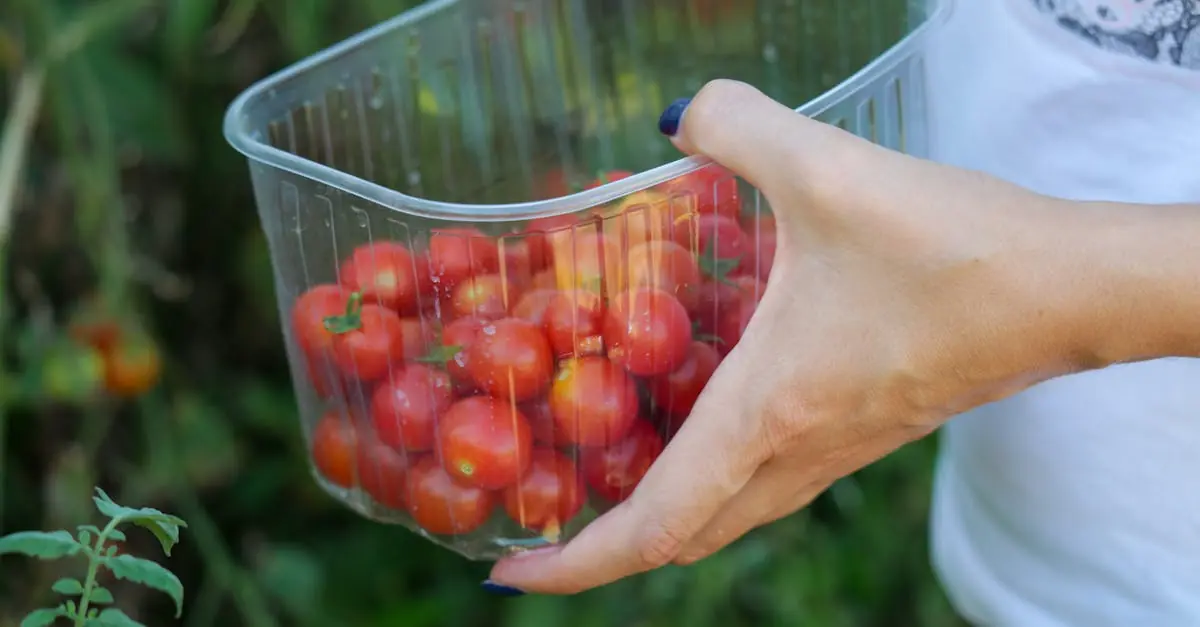Container gardening is like the magic show of the gardening world. With just a few pots and a sprinkle of creativity, anyone can transform a balcony or patio into a lush vegetable paradise. No sprawling backyard? No problem! Even the tiniest of spaces can yield a bountiful harvest, and the best part? You don’t need a green thumb; just a little enthusiasm and the right veggies.
Table of Contents
ToggleBest Vegetables for Container Gardening
Container gardening allows for many vegetable options, making it easy to find selections that thrive in limited space. Leafy greens, such as spinach and lettuce, flourish in containers. These vegetables prefer cooler temperatures and grow quickly, providing harvests within just weeks.
Tomatoes rank among the most popular choices for container gardening. Varieties like cherry tomatoes and determinate types require minimal space and offer high yields. They enjoy full sun and should be provided with sturdy support as they grow.
Peppers also adapt well to container gardening. Bell peppers and hot peppers thrive in pots, needing warm temperatures and consistent watering. These vegetables can add flavor to various dishes and come in numerous colors.
Carrots present another suitable option, fitting comfortably into deeper containers. They require loose soil to grow straight and long, making pot depth important. Radishes are a quick-growing alternative, offering fast results within roughly three to four weeks.
Herbs, while not vegetables, significantly enhance container gardens. Basil, parsley, and chives pair well with other vegetables, adding freshness to meals. These plants often grow well alongside tomatoes and peppers.
Finally, consider dwarf varieties of squash or cucumbers. These compact plants occupy less space and produce abundant vegetables. Proper trellising can further optimize growth in containers.
With careful selection, container gardening becomes an accessible and rewarding experience for anyone eager to grow their own food.
Types of Containers
Choosing the right container is crucial for successful container gardening. Various types suit different needs and preferences.
Plastic vs. Clay
Plastic containers are lightweight and come in various sizes and colors. These pots usually retain moisture well and are less prone to cracking in cold weather. Clay pots, on the other hand, offer a classic aesthetic and excellent breathability for plant roots. They absorb moisture, which can help reduce overwatering but may dry out faster. Each option has its advantages, so gardeners can consider both based on their specific conditions and preferences.
Size Considerations
Container size impacts root growth and overall plant health. Small pots, typically around 6 to 8 inches in diameter, work well for herbs and smaller vegetables like radishes. Medium pots, ranging from 10 to 14 inches, accommodate larger plants such as peppers or determinate tomatoes. Larger containers, 16 inches or more, are ideal for root vegetables like carrots or deep-rooting plants like squash. Providing adequate room for growth enhances yields and ensures thriving plants.
Best Vegetables for Small Spaces
Container gardening allows for the cultivation of various vegetables in compact areas. Selecting the right types enhances the gardening experience.
Leafy Greens
Leafy greens excel in container gardening. Spinach and lettuce thrive in limited spaces and cooler temperatures. Arugula and kale also perform well, requiring minimal care while providing nutritious harvests. Potting these greens in medium-sized containers encourages ample root growth. Regular watering and well-draining soil contribute to successful yields. Choose varieties that mature quickly, ensuring a fast turnaround from seed to salad.
Herbs
Herbs complement vegetable gardens and thrive in containers. Basil, parsley, and chives adapt perfectly to confined areas. These herbs require consistent watering and sunlight for optimal growth. Often, smaller pots suffice, allowing easy access for harvesting. Consider using various herb containers for a diverse flavor palette. Growing herbs alongside vegetables maximizes the use of space while enriching dishes with fresh flavors.
Vegetables That Thrive in Containers
Growing vegetables in containers offers various options for urban gardeners. Selecting the right varieties ensures a productive garden even in limited spaces.
Tomatoes
Tomatoes excel in containers, especially cherry and determinate types. These varieties produce abundant fruits with minimal space requirements. Full sun exposure promotes optimal growth, making sunny balconies ideal. Watering consistently aids in preventing blossom end rot and supports fruit development. Fertilizing every few weeks enhances yield and ensures nutrient-rich produce. Choose containers at least 5 gallons for proper root expansion. Success with tomatoes often leads to a rewarding gardening experience.
Peppers
Peppers thrive in containers, including both bell and hot varieties. These plants appreciate warm conditions, thriving in temperatures above 70°F. Adequate watering keeps the soil consistently moist but not soggy. A pot size of 3-5 gallons supports healthy growth, giving roots ample room. Varietal selection allows gardeners to enjoy sweet or spicy flavors. Regular feeding throughout the growing season encourages fruit production. With the right care, container-grown peppers yield delicious results.
Tips for Successful Container Gardening
Successful container gardening hinges on several factors, including appropriate soil, fertilization, and proper watering techniques. Mastering these elements ensures healthy growth for vegetables and herbs in limited spaces.
Soil and Fertilization
Quality soil enhances growth in container gardening. A balanced potting mix, rich in organic matter, promotes root development and moisture retention. Selecting a mix specifically designed for container use guarantees proper drainage and aeration. Alongside soil, regular fertilization boosts nutrient levels. Using a water-soluble fertilizer every two to four weeks supports vigorous plant growth. This method prevents nutrient depletion, especially for fast-growing vegetables. Gardeners should consider slow-release fertilizers as alternatives for maintaining consistent nutrient availability throughout the season.
Watering Techniques
Watering demands attention in container gardens. Due to their limited soil volume, containers dry out quickly, necessitating daily checks, particularly in warm weather. Ensuring adequate moisture prevents stress on plants. Implementing a deep watering method is effective; this allows water to saturate the root zone. Container gardening also benefits from self-watering pots, which regulate moisture levels efficiently. Observing plants for signs of wilting informs adjustments in watering frequency. Maintaining consistent moisture supports healthy growth and maximizes yields.
Container gardening opens up a world of possibilities for anyone looking to grow their own vegetables. With the right vegetable choices and proper care, even the smallest spaces can yield bountiful harvests. Leafy greens tomatoes and peppers stand out as excellent options for those starting their gardening journey.
By selecting the right containers and maintaining consistent watering and feeding practices, gardeners can enjoy fresh produce right from their balconies or patios. Embracing the creativity and accessibility of container gardening not only enhances culinary experiences but also fosters a deeper connection to nature. With enthusiasm and a little planning, anyone can transform their space into a thriving garden oasis.




